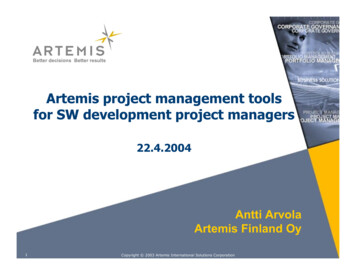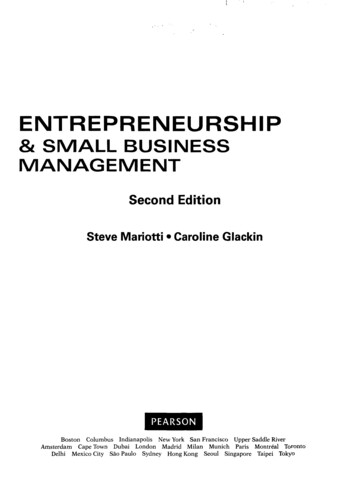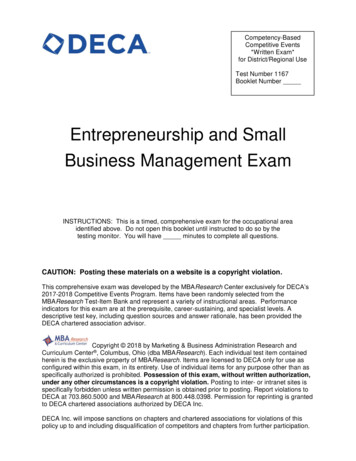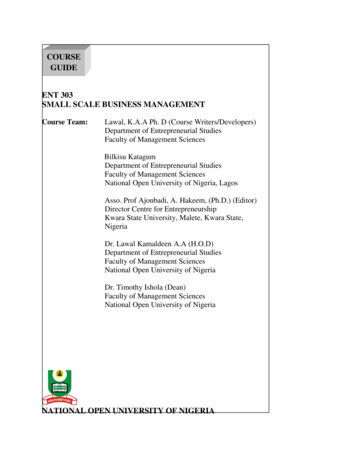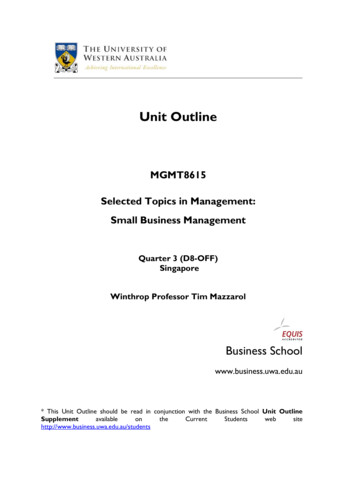
Transcription
Simple Project Managementfor Small BusinessSix Easy Steps to Success
NOTICEYou MAY Give Away This Report Freely To Anyone You Choose, However It MustRemain Intact In Its Published FormYou MAY Also:Tweet About It - Click here to Tweet Now!Share It On LinkedIn - Click here to Share Now!Talk About It On Facebook - Click here to Share Now!Tell People About It On Google - Click here to Share Now! 2012 GetAppThis work is licensed under a Creative Commons Attribution-NoDerivs 3.0 Unported License.GetApp would like to thank the following people for their contributions to this book. Eleanor Mayrhofer – e.m.papers Elizabeth Harrin – A Girl’s Guide to Project Management Josh Nankivel – pmStudent Lyndsay Scott – Arras People Peter Taylor – The Lazy Project Manager
Table of ContentsIntroduction 1What is Project Management? 3Why Is Project Management Useful For Small Businesses? 56 Easy Steps To Start Managing Projects In Your Small Business 7Things That Can Go Wrong With Your Project 105 Steps To Find Software That Can Help You Manage Your Projects 12Resources To Help You With Project Management 14Courses/Certifications 14Infographics 14Blogs and Articles 15Project Management Software Reviews 16Connect With Project Managers On Twitter 16Other Project Management Resources 17Common Project Management Terms 18Share this ebook! 20
IntroductionMuch of the time when people hear the term “project management,” it conjures up avisual of huge projects that take hundreds of people, lots of money, and a good bit oftime to complete.But the reality is, many projects are much smaller than those we imagine. Most smallbusiness owners juggle numerous projects at any given time. You may not think ofthe things that you do as projects, but consider this list for a moment. Remodel your website Develop a new marketing campaign Create a new product offering Hire an employee Coordinate a joint venture Plan a newsletter Deliver client servicesAny of those sound familiar to you? These are just a few of the projects you mightbe involved in at any given point in time. And, most likely, you’re juggling multipleprojects at the same time.That means you have to coordinate resources and manage deliverables for multiple1
items all at once. And the problem with that is things can fall through the cracks. Howwould you answer the following questions? Do your projects get done on time? Do your projects make money? Do you track work as it gets done? Do you monitor how much money and time is being spent during a project? Has a customer ever said, “This isn’t what I wanted.”If you answered no to any of the first four questions or yes to the last one, it’s time foryou to take a serious look at how project management can help your small business.2
What is Project Management?It’s likely you’ve encountered problems in your business that were tough to solve.Project management is an organized process that can help you solve those problemswith the least amount of hassle. It sounds complicated, but it’s not. Have you had anyof these problems in your business? Miscommunication between team members Client product delivery that had to be reworked when you thought it wascomplete Overruns on client projects Missed delivery dates on client projects A recurring internal problem that just won’t go awayYou’re not alone. Many small businesses struggle with these very same issues. Andmost small businesses can’t afford to waste time and effort spinning their wheels toaccomplish work. It can be the catalyst that puts you out of business. Using a projectmanagement approach in your business can minimize confusion, rework, errors andbest of all, it can help you delight your customers.So what’s the “official” definition of project management?According to the Project Management Institute (PMI), which is known as the authorityfor project management knowledge and processes, the short definition of a project is“a temporary endeavor undertaken to create a unique product or service.”3
And here’s the long version:“Project management, then, is the application of knowledge, skills and techniquesto execute projects effectively and efficiently. It’s a strategic competency fororganizations, enabling them to tie project results to business goals — and thus,better compete in their markets.”If you ask ten people the definition of project management, you’re likely to get tendifferent answers. We tapped a few of the most influential project managementprofessionals on the internet for their definition:“Getting something newand exciting done witha group of people!”Peter Taylor“Leading teams tocreate something new!”Josh NankivelWhat isProjectManagement?“Project managementfor me is all aboutmanagement first.”Lindsay Scott“Project managementis the art and scienceof getting things done.”Elizabeth Harrin4
Why Is Project Management Useful ForSmall Businesses?Small businesses don’t have the luxury of abundant resources to accomplish eachtask. It’s likely that every employee in your business wears several hats at a time.That’s why project management is so useful for small business. It will help you makethe most of your resources (even if the only resource is you), manage your budget,and deliver quality solutions to your customer. It can even help you make yourinternal business processes work better so it takes less time and effort to get thingsdone. In short, project management can help you turn chaos into order.Here are four reasons why project management is so valuable to small business:1. Makes big goals achievable – With a project management approach to yourgoals, you can seize opportunities, solve problems and realize the success youseek.2. Reveals gaps and pitfalls – All projects are not meant to become reality. Ifyou’re like most small business owners, you have more ideas than you couldcomplete in a lifetime. Using a project management approach can help you seethe gaps in your thinking and provide the “cons” of completing a project beforeyou’ve invested a lot of time, resources, and money in the project.3. Breaks down the overwhelm – Do you dream big and then get exhaustedthinking of all the things that have to be done to realize that dream? Projectmanagement helps you “chunk up” the work into bite sized pieces so you canmake progress and avoid getting so overwhelmed that you get nothing done.5
Nothing can motivate more than small rewards along the way to achieving a biggoal.4. Gets the work out of your head – Writing down what needs to be done toaccomplish your goals will help you get done faster without a lot of rework.Having to remember everything that needs to be accomplished just clutters upyour brain and creates a prescription for disaster.One of the main advantages of being a small business is using innovation andcreativity so you can get products and services to market quicker. It gives you acompetitive advantage.Project management expert Lindsay Scott says, “Project management in smallbusinesses not only allows them to remain competitive through change andinnovation but it also allows an organization to manage these changes in a structuredway, increasing the likelihood that any project would be delivered successfully.”And that’s the objective – to deliver projects successfully – so you can sustain yourbusiness.But you don’t have to go “full out” with the PMI structured Project ManagementBody of Knowledge (PMBOK) on managing your projects. Scott adds, “Adoptingeven a ‘light touch’ project management framework can enable an organization toeffectively choose which projects to run; when to run them and by whom. With projectmanagement comes control and with control comes the ability for management tokeep a tight rein on developments that affect the future of the business.”6
6 Easy Steps To Start Managing ProjectsIn Your Small BusinessWay too many small business owners use a “Fire, Ready, Aim” approach toaccomplishing projects. In the short run, this method may seem faster than planningyour efforts, but this approach is fraught with danger and can cost your business losttime, money, effort and worst of all, dissatisfied customers.It’s been proven time and again that planning ahead can save time, money, and effortwhen it comes to projects. The basic premise is that an issue found in the planningstage will cost a lot less than an issue uncovered later in the lifecycle of your project.This is known as the 1:10:100 rule. Here’s the breakdown. It’s least expensive to plan well and resolve all problems in the concept andplanning stages of your project. If an issue is not resolved in the planning stage, it will cost 10 times more in thedevelopment stage Lastly, it will cost 100 times more if the issue is uncovered after the project hasbeen delivered.There’s a lot of value in thinking through and planning your projects before beginning.It’s not rocket science by any stretch of the imagination. You simply need to clearlydefine the “Why, What, How, Who, and When” of getting things done before youactually begin the work.7
Small business owner Eleanor Mayrhofer – a corporate refugee like many of today’ssmall business owners – developed a methodology for completing projects whenshe was launching and growing her business e.m.papers. She calls it “Steal ThisProcess” and it’s specifically focused on helping small business owners use a projectmanagement approach to getting things done.Her method describes essential steps to take into account every time you arethinking of starting a project to avoid complications and wasted effort. It’s structuredaround six simple steps that are important to successful projects: Defining Goals,Developing Scope, Estimating, Planning, Executing and Reviewing.1 - GoalsThe first step is to define the “Why” of your project. Think about and write down whatyou want to achieve at the conclusion of this project. This is the basic foundation ofyour project and what will guide you along the way.2 - ScopeWith your goals in mind it’s time to think about the “What.” At this point you shouldthink about the deliverables of the project. What has to be done in order to achievethe proposed goals above? Define each of the tasks so it is clear what needs to bedone.8
3 - EstimationAt this step you should define an estimate of how long each of the defined tasks willtake to be completed.4 - PlanningYou already know what has to be done and how long each of the tasks will take,now you will use that information to identify how long it will take depending on theresources you have available. Put it on a timeline so you will have a visual of the totaltime it will take to achieve your goals and complete your project.5 - ExecutingIt’s time to get things done. Check your plan daily and follow the tasks you haveidentified. Problems can appear, so update your plan as you go to keep everythingon track. Most important in the execution phase is not straying from your plan.6 - ReviewingReviewing the project is part of the process to ensure you stay on track. You’ll wantto do this periodically as you progress through your project and at the end when theproject is complete. Reviewing will help you understand what worked, what didn’twork, and will provide you with valuable insight for the next project.9
Things That Can Go Wrong With YourProjectIn a perfect world, your projects will go from start to finish without any changes orproblems. But we don’t live in a perfect world and the reality is, you will encounterproblems along the way and be required to make adjustments on the fly to ensure asuccessful end to your project.There are any number of things that can go wrong, so we tapped Peter Taylor, TheLazy PM, to find out some of the more common problems you could encounter inyour project. I couldn’t deliver the project in the estimated time. What happened?To answer the “what happened,” don’t be afraid to run a simple lessons learnedprocess to identify the cause of any variances to estimates. Were you too optimisticabout what you could achieve? Were the tasks not specified to the right level? Alltasks should be broken down to short work packages to allow good tracking of yourprogress. Some tasks can’t be done in the assigned time and it’s delaying theproject.First, recognize this as an issue for any future projects – you’ll want to learn whythis is the case and how you can avoid repeating the problem in the future. Second,take the time to review all of the outstanding tasks and, based on the actual timeto complete earlier tasks, re-baseline the project to determine a realistic projectcompletion date.10
I can’t handle managing so many projects.A sure sign of this is when you spend 100% of your time “report producing” ratherthan actually managing projects. Too many projects means that you have to prioritize– assess of risk impact of all of your projects failing to deliver so you can give eachproject the right level of attention. The tool I wanted is too expensive for what I really need.Do you really understand what it is that you do need? It is often best to use standardoffice and other tools when you start managing projects so you really learn what it isthat you ‘need’ to manage the project. And then, after a period of time, you can betterarticulate what it is that is essential to your requirements and what software will helpyou with your project management tasks.11
5 Steps To Find Software That Can HelpYou Manage Your ProjectsWhen you start out using a project management approach to getting things done inyour small business, you’ll most likely use the tools at hand – MS Office tools likeWord and Excel, Google Docs or just plain paper and sticky notes. Those will workfine for you, but you may find as you become more adept at project management thatyou want a software tool to help you become even more productive.It’s important to find the right tool to help you achieve those goals, so here’s a fi
That’s why project management is so useful for small business. It will help you make the most of your resources (even if the only resource is you), manage your budget, and deliver quality solutions to your customer. It can even help you make your internal business processes work better so it takes less time and effort to get things done. In short, project management can help you turn chaos .File Size: 973KBPage Count: 23




